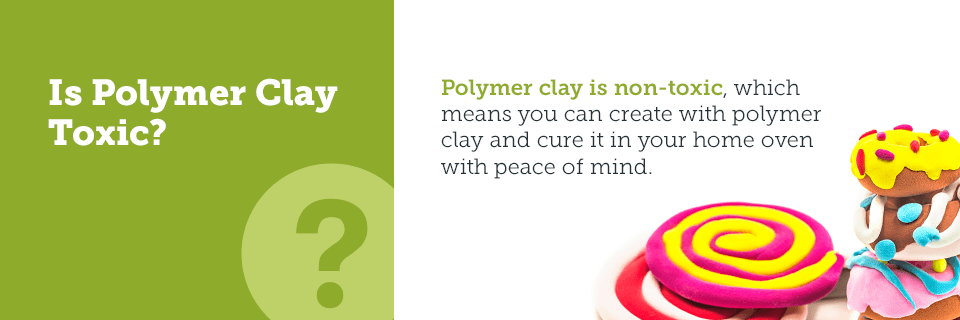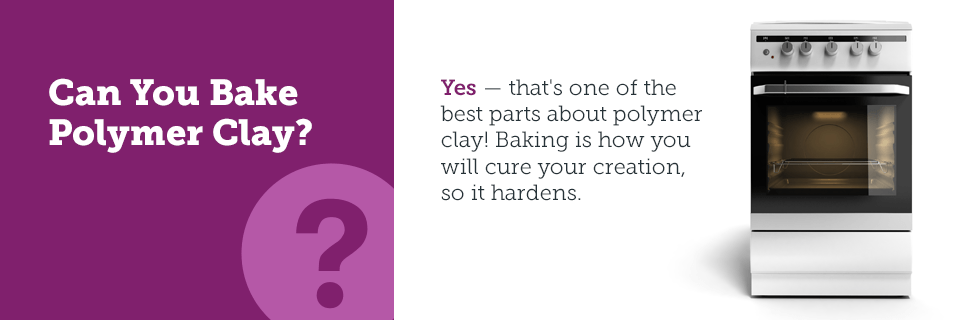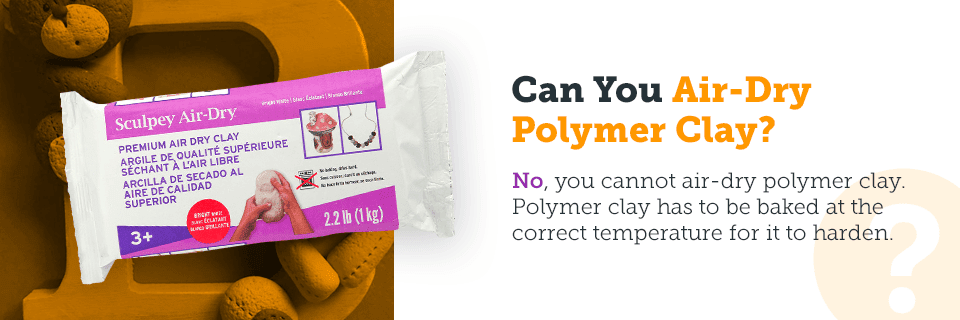
Table of Contents:
- What Is Polymer Clay Made out Of?
- How Is Polymer Clay Used?
- What Can You Make With Polymer Clay?
- Are Modeling Clay and Polymer Clay the Same Thing?
- Is Polymer Clay Toxic?
- What Is the Best Polymer Clay?
- Can You Bake Polymer Clay?
- How Do You Bake Polymer Clay?
- Can You Bake Polymer Clay in a Microwave?
- Can You Bake Polymer Clay on Aluminum Foil?
- Can You Burn Polymer Clay?
- How Do You Firm up Polymer Clay?
- How Do You Soften Polymer Clay?
- What Do You Use to Glaze Polymer Clay?
- Do You Paint Polymer Clay Before or After Baking?
- Can You Air-Dry Polymer Clay?
Polymer clay is a fun, highly versatile medium. You can form just about anything with it, from beaded necklaces to unique picture frames. This medium is a popular choice for artists, sculptors, jewelry makers, crafters, animators and anyone who wants to relax and get in touch with their creative side. Polymer clay is also an excellent medium for kids, who love to roll the clay in their hands and build imaginary worlds.
Whether you’re new to the world of polymer clay or are an experienced clayer seeking the answer to a specific question, we’ve provided answers to frequently asked queries so you can start your project with confidence. Let’s get started on your journey to fun and creation with Sculpey® polymer clay products — you’ll be amazed by the possibilities.
If you are looking to buy polymer clay online, check out our different clay options.
What Is Polymer Clay Made out Of?
Polymer clay is a synthetic material created from a plastic polymer base — polyvinyl chloride (PVC). One of the most widely used plastics in the world, PVC is used in objects all around us, from medical devices to children’s toys. Polymer clay incorporates other components for malleability, softness, hue and texture, including:
- Flexible plasticizers
- Texture-adding fillers
- PVC resins
- Coloring agents
Unlike natural waterborne clays, polymer clay will not harden when you leave it out at room temperature, which means you can set projects aside and return to them later. You also don’t have to worry about replacing clay if you forget to put it away, as long as you keep it from heat and direct sunlight.
Does polymer clay harden as it cools? Also, polymer clay will not harden when you leave it out at room temperature, which means you can set projects aside and return to them later. You also don’t have to worry about replacing clay if you forget to put it away, as long as you keep it from heat and direct sunlight.
How Is Polymer Clay Used?

Sculpey® clay can be used by anyone, at every skill level. To make crafts and décor with polymer clay, take the following steps:
- Protect: Unbaked clay can stain or damage work surfaces, so be sure to use a protective surface under your clay project. Cover your work area with aluminum foil or parchment paper, or shape your project on top of a ceramic tile, metal baking sheet or piece of glass.Condition: Condition your clay to improve its flexibility and reduce the chance of breaking. Use your hands to roll, knead and stretch the clay. Quickly and easily condition your clay using a pasta machine or our Sculpey Tools™ Clay Conditioning Machine.
- Shape: Use your hands and a variety of tools to shape and texture your clay creations. Our curated Sculpey Tools™ Essential Tool Kit includes the clay-shaping, cutting and detailing tools needed to simplify and improve your creative process.
- Store: Although polymer clay will not air-dry, proper storage will keep it the freshest. We recommend storing unused clay in bags or containers made of polypropylene (PP) plastic. PP containers have a number 5 on the bottom. Storing clay in environments exceeding 77 degrees Fahrenheit will compromise it. Keep the clay in a cool, dry area away from direct sunlight, and you’ll have fresh clay for a long time. You can even refrigerate or freeze your clay to extend its life.
- Bake: To cure the clay, place your finished creation on a ceramic tile or our Sculpey Tools™ Oven-Safe Work Mat. Transfer it into a toaster oven or conventional household oven to bake. Baking varies based on the clay type and thickness of your project. Always use the recommended baking times and temperatures — follow the precise clay instructions on the packaging.
- Finish: Once the clay is baked and cool, you can sand and buff your craft, then paint and seal it with a glaze. It’s entirely up to you if you wish to take these steps. Polymer clay is durable and waterproof without a glaze, so you might choose to leave your masterpiece as-is.
What Can You Make With Polymer Clay?
The possibilities are endless when it comes to how you can use polymer clay. Many jewelry makers prefer polymer clay over glass because, unlike glass, polymer clay is much easier to work with, does not require an open flame and produces gorgeous results. You can shape polymer clay to resemble gemstones, marble or glass using various techniques and clay types. Also, polymer clay is less likely to chip or break than glass.
Another fun way to use polymer clay is to cover an already-made object with the medium. For example, you can decorate a picture frame with polymer clay letters to form a name or heartfelt message. Or you can cover a pen with polymer clay with playful patterns to make homework sessions much sweeter. There is no limit to the ways you can clay. Here are just a few projects you can make for inspiration:
- Jewelry
- Vases
- Beads
- Holiday ornaments
- Keychains
- Figurines
- Dolls
- Miniatures
- Wall art
- Garden décor
- Candleholders
- Keepsake boxes
- Journal covers
- Bookmarks
- Just about anything you can dream up
If you’ve never worked with polymer clay before and aren’t quite sure where to begin, we’ve got you covered! Dive into our handy beginner’s guide for practical tips to start your clay shaping journey with confidence, even with zero experience.
Are Modeling Clay and Polymer Clay the Same Thing?
Does this modeling clay dry out? Wax-based modeling clay and polymer clay are not the same. Modeling clay, like our Sculpey® Non-Dry, does not dry out and cannot be cured. Modeling clay is meant to be reused time and time again. It is a self-sticking material and a fun way for beginners to practice their claying skills. Crafters interested in clay animation might choose modeling clay to shape and reshape different figures quickly.
If you wish to create objects such as jewelry, clothing embellishments, home décor and the like, we recommend polymer clay because you can cure your creations for long-lasting results.
Is Polymer Clay Toxic?

Our polymer clays are AP-certified non-toxic products approved by the Art and Creative Materials Institute, which means kids and adults can create with Sculpey® clay and cure it at home in the oven with peace of mind. Remember, it’s still crucial to follow package baking instructions. Just as you would not want to burn a cake in your home oven, you wouldn’t want to burn your polymer clay.
All our polymer clay products are free of common allergens — our products do not contain any wheat, dairy, gluten, sulfur, nuts, tree oils, egg materials or latex. Even though polymer clay is non-toxic, we do not recommend eating it or combining it with utensils or other items that directly touch food. Cured polymer clay is porous. If you try to use a finished creation as a food utensil, it won’t be easy to clean sufficiently with dish soap, unlike other utensil materials.
While safe, in its unbaked form, the plasticizers in polymer clay may react with wooden furniture, countertops, carpet and other porous surfaces. Prevent possible stains or damage by using a protective surface under your polymer clay.
What Is the Best Polymer Clay?
Sculpey® is the best brand of polymer clay you can buy! Check out our product recommendations by skill level and project type to choose the best Sculpey® clay for your creation:
- For kids: Soft and easy for small hands to condition, Sculpey Bake Shop®, Sculpey® III and Original Sculpey® are great for kids to bring their imagination and school projects to life. Young kids love to play with Sculpey Bake Shop® Light™, which is perfect for making water toys because it floats after baking. Sculpey Bake Shop® and Sculpey® III are available in a range of fun colors perfect for making animals, spaceships and magical creatures.
- For beginners: New clayers can learn how to shape polymer clay, grow detailing skills and explore their imagination with easy-to-use Sculpey® III. This versatile medium is available in a variety of colors, including metallics, and is an excellent choice for home décor projects, simple jewelry pieces and more. Beginners use Original Sculpey® to create earthen clay-colored vases and bowls that look and feel like ceramic clay.
- For professional crafters: Experienced clayers love Sculpey Premo™ for its precise color mixing and ability to hold fine detail. Sculpey Premo™ is available in specialty colors such as glitters, fluorescents and opals to produce jaw-dropping jewelry. Another favorite among seasoned makers, Sculpey Soufflé™ is a lightweight professional polymer clay perfect for large projects because it holds fine details and resists cracking.
- For jewelry makers: Create beautiful earrings, pendants and beads with our specially designed clays. The pearl, granite, glitter, metallic, fluorescent and translucent colors of our Sculpey Premo™ are perfect for beads and duplicating the look of semi-precious stones. Liquid Sculpey® is a liquid form of polymer clay — pour this unique material into molds to create jewelry pieces in on-trend crystal-clear and translucent finishes.
- For professional sculptors, model makers, doll artists and movie studios: Professional doll and figure artists use semi-translucent Super Sculpey® Living Doll for its capacity to mimic the glow of real skin. Industry professionals turn to the firm, organic-detail-holding quality of Super Sculpey® to form imaginative masks, creatures, special effects and molds.
Can You Bake Polymer Clay?

Yes, you can bake polymer clay — that’s one of the best parts about this type of clay! Baking is how you will cure your creation so it hardens. After you bake your clay and allow it to cool, you can paint it, apply a glaze, add embellishments or leave it exactly as it is. The best part about baking polymer clay is it allows you to keep your creations forever. Once the clay hardens, you’ll have durable objects you can cherish and use to inspire your next clay project.
How Do You Bake Polymer Clay?
To bake your polymer clay masterpiece, we recommend you test your oven’s temperature first because many conventional ovens are not the exact temperature you set them at. Testing your oven will help you ensure your creation cures properly. You’ve likely put your heart into your creation, so an oven test is definitely worth the time.
Always use an oven thermometer to test your oven’s temperature and ensure it’s accurate before you bake your project. Oven thermometers are inexpensive and will help you produce the desired results. To test your oven, all you need to do is:
- Pinch off a small piece of clay.
- Form a disk about a half-inch in diameter and a quarter-inch thick.
- Preheat the oven temperature according to package instructions.
- Use an oven thermometer to make sure your oven reaches and stays at the correct temperature — be sure to place the thermometer exactly where you plan to bake your creation.
- If the thermometer indicates a temperature difference between the oven gauge and the actual internal temperature, take note and adjust your oven settings before baking.
- Bake the test clay piece per package instructions.
- Remove the piece from the oven and check the colors.
- If the piece has darkened anywhere, your oven is too hot.
- If the oven is too hot, lower the temperature by 10 degrees Fahrenheit and try the test again.
When you’re ready to bake your creation, follow these steps every time:
- Preheat your oven to a thermometer-checked temperature according to the package instructions.
- Bake your creation on an oven-safe material such as oven-proof glass, metal baking sheet or our Sculpey Tools™ Oven-Safe Work Mat.
- Follow the instructions, and do not bake the piece too long.
- Once the time is up, remove your creation from the oven and allow it to cool.
Can You Bake Polymer Clay in a Microwave?
Microwaves also often cook things unevenly, which means part of the clay would harden in the microwave, while other parts would stay soft. Microwave cooking could cause the clay to overheat and scorch. Even when non-toxic materials burn, the resulting smoke may irritate your eyes and lungs.
The best polymer clay results happen when you practice patience, follow instructions and bake creations correctly. After spending quality time and effort on your piece, you deserve to have your final project turn out right so you can enjoy it for a long time or give it as a gift.
Can You Bake Polymer Clay on Aluminum Foil?
Yes, you can bake polymer clay on aluminum foil. Aluminum foil is a commonly used companion of polymer clay during the baking process. It’s an excellent material for lining cookie sheets or other baking surfaces you use for cooking. For example, if you plan to reuse a baking sheet for cookies after baking your polymer clay project, it’s best to lay down aluminum foil before placing the clay on the baking sheet.
You should especially line pans and trays if you’ll use them for food later. Clay should not directly touch surfaces intended for food use. The aluminum foil acts as a safety barrier between the clay and the baking surface.
In addition to aluminum foil, you can also safely use parchment paper or card stock paper under your clay creations in the oven since paper will not catch fire at such low temperatures.
Can You Burn Polymer Clay?
Yes, polymer clay can burn if you do not bake it according to package instructions. Just like anything you would bake in the oven, if you bake clay too hot for too long, it will burn. That is not the ideal outcome for your beautiful creations. However, polymer clay does not burn easily. If you follow the polymer clay instructions and set your oven to the accurate temperature with an oven thermometer, it’s highly unlikely your creation will burn.
To prevent possible burning, always test your oven temperature, follow baking instructions precisely and try to keep polymer clay as far away from the heating element as possible. If you ever accidentally burn clay in your oven, we recommend you thoroughly clean your oven and the rest of your kitchen surfaces.
How Do You Firm up Polymer Clay?
To change the consistency from soft, squishy clay into a firmer consistency clay follow these simple steps:
- Protect your work surface.
- Roll the clay into sheets about a quarter of an inch thick.
- Sandwich the sheets between sheets of clean, white paper.
- Place a book as a weight on top of the sheets of paper.
After about an hour, the paper surfaces will begin to look oily. These are the plasticizers coming out of the clay, which made it too soft. Change the paper a few times and repeat the process until the clay reaches the desired softness.
How Do You Soften Polymer Clay?

Before you reach for an additive to adjust the softness of your standing clay, take the time to condition it thoroughly. Before polymer clay is conditioned, especially new clay, it can appear stiff and firm. The warmth of your hands and dedicated kneading can convert your clay to the desired flexibility and softness.
After conditioning, if the clay is still a bit too firm or dry, you can add a clay conditioner to transform the clay into a softer, more pliable consistency. Sculpey® Oven-Bake Clay Softener is a solid clay conditioner, while Sculpey® Liquid Clay Thinner & Softener comes in liquid form. These softeners have no pigment, so they won’t change the color of the clay you’re conditioning.
Add a few drops at a time, starting with two to four drops per 2 ounces of clay, and knead the liquid in thoroughly before adding more. The clay will soften as it absorbs the liquid. If you’ve accidentally added too much softener, roll clay into sheets and place them between pieces of paper to leach out some of the plasticizers.
What Do You Use to Glaze Polymer Clay?

Use Sculpey® Gloss Glaze or Sculpey® Satin Glaze to create your desired seal and finish. A glossy glaze adds shine and an extra protective layer to increase your creation’s durability. The satin glaze provides a smooth matte finish and primes projects for paint or added decorative details like glitter or metal leaf.
Although you do not need to seal polymer clay with a glaze, clay finishes help make a project look complete. You can also use compatible floor waxes, water-based acrylics or water-based fabric paints as sealers.
Before you add any glaze, we suggest sanding and buffing your piece first, then testing the glaze. To test the glaze, apply it to a hidden portion of the piece and allow the glaze to dry completely to ensure the materials interact well. Stir the glaze well, avoid air bubbles, then apply two or three thin coats of glaze to build up your finish.
If the glaze is too thick, try adding a few drops of water to thin it out, then gently stir. Put the cap back on and let it sit for about an hour before use.
Do You Paint Polymer Clay Before or After Baking?
For many projects, it’s best to apply paint after the piece is done baking and has hardened. Imagine painting a delicate creation that is still soft — it adds a challenge to prevent distorting the clay during the painting process.
To paint cured projects, we recommend using water-based acrylic paints and testing a small piece of the clay first to check the interaction between the paint and the clay. Plan to seal the piece with Sculpey® Gloss Glaze or Sculpey® Satin Glaze? You can use any paint before glazing. The glaze will help preserve the colors, as long as you keep your project out of direct sunlight.
Can You Air-Dry Polymer Clay?
 No, polymer clay cannot be air-dried. Polymer clay was designed to be baked in an oven to cure and harden.
No, polymer clay cannot be air-dried. Polymer clay was designed to be baked in an oven to cure and harden. Clayers adore polymer clay because they don’t have to worry about it drying out. You can leave our clay out at room temperature if you need to step away mid-project for a few hours, no problem! Your creation won’t harden before you’re ready to bake — the clay will be ready for your continued creative magic the moment you return. As long as you store unbaked polymer clay properly, it can last many years.
Don’t have access to an oven? We carry air-dry modeling clay options. Check out our Sculpey Air-Dry™ and Sculpey Air-Dry™ Porcelain clays to create quality air-dried projects.
Buy Sculpey Polymer Clay Today
Whether you’re a beginner or a professional, polymer clay provides hours of crafting joy! To start on the right foot, treat yourself to the best polymer clay brand there is — Sculpey®.
Sculpey® is famous for quality, versatility and inspiring colorful ideas. Crafters, clayers and sculptors prefer Sculpey® polymer clay because they know they will get a durable product that fosters creativity and brings their artistic visions to life. Sculpey® stimulates the imagination like no other medium and allows crafters to create anything they want — from stunning jewelry pieces to figurines straight from a fantasy novel.
Best of all, anyone can use Sculpey® polymer clay and make something unique they can cherish forever or give to a friend. To get started enjoying the relaxing and fun world of claying with Sculpey®, browse our online store today.
Are you looking for inspiration? Check out our how-to page, and you’ll be crafting in no time!
Don’t see your question on this list? Check our FAQs page or contact us!



